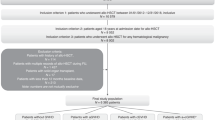Abstract
We analyzed hospital charges for pediatric hematopoietic stem cell transplantation (HSCT) to understand better the medical origin of these charges. Forty-nine patients undergoing HSCT at Kosair Children’s Hospital between January 1992 and August 1995 had hospital charges analyzed by cost center, donor type and clinical outcome. Thirty-three autologous, two syngeneic and 14 allogeneic transplants were performed. Twenty-four transplants were performed for hematological malignancies, 22 for solid tumors, and three for non-malignant diseases. Pharmaceutical charges comprised the largest single component of total hospital charges (THC), accounting for 38.9%. Room charges were the next largest group at 33.7% of THC. Other cost centers, in order of magnitude, were central supply (7.9%), transfusion services (7.5%), laboratory (5.8%), microbiology (3.6%), miscellaneous (1.9%), and radiology (1.4%). Within the pharmaceutical cost center, colony-stimulating factors comprised the largest single item, making up 18% of total pharmacy charges and 7% of THC. Antibiotics were the second largest component, at 16% of pharmacy charges and 6% of THC. Patients transferred to the intensive care unit (ICU) had charges 68% greater than non-ICU patients. Allogeneic transplant patients had THC 35% greater than autologous transplant patients, but also a four-fold greater chance of becoming an ICU patient. THC for non-ICU allogeneic transplant patients were 18% greater than for autologous non-ICU patients. THC for allogeneic ICU patients were 21% greater than for autologous ICU patients. Patients who died of transplant-related toxicity prior to day 100 had THC 83% greater than those who survived beyond day 100. This is the first published comprehensive and detailed analysis of charges associated with hematopoietic stem cell transplantation. With increased emphasis on the provision of cost-effective care in both Europe and the USA, medical practices must be examined with the goal of reducing inefficiencies while preserving quality of care. Understanding the genesis of charges in expensive procedures such as stem cell transplantation is an initial step in cost containment.
This is a preview of subscription content, access via your institution
Access options
Subscribe to this journal
Receive 12 print issues and online access
$259.00 per year
only $21.58 per issue
Buy this article
- Purchase on Springer Link
- Instant access to full article PDF
Prices may be subject to local taxes which are calculated during checkout
Similar content being viewed by others
Author information
Authors and Affiliations
Rights and permissions
About this article
Cite this article
Kline, R., Meiman, S., Tarantino, M. et al. A detailed analysis of charges for hematopoietic stem cell transplantation at a children’s hospital. Bone Marrow Transplant 21, 195–203 (1998). https://doi.org/10.1038/sj.bmt.1701065
Received:
Accepted:
Published:
Issue Date:
DOI: https://doi.org/10.1038/sj.bmt.1701065



